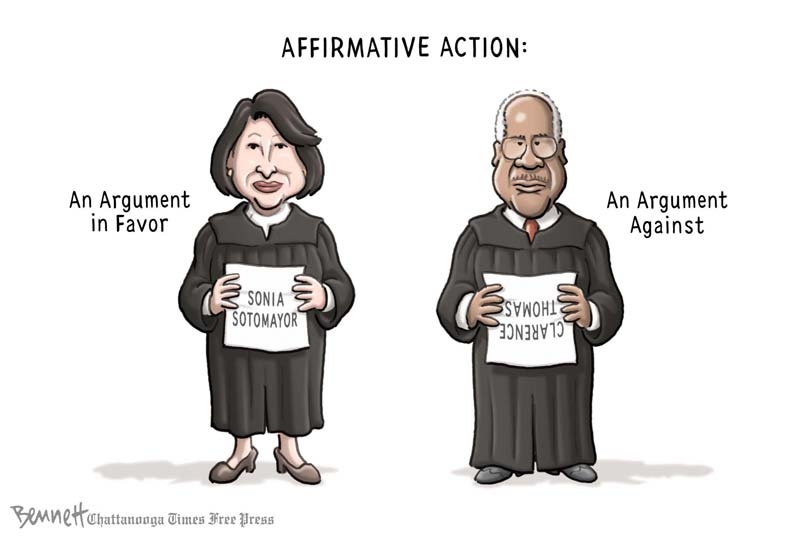The Supreme Court, in its finite wisdom, has decided that colleges cannot decide for themselves who they want to admit to their schools. (“Government should get off the back of businesses” is a Republican motto that doesn’t apply if the businesses are doing something the Republicans disagree with.)
The Court (a majority of whom were appointed by Presidents that lost the popular vote) has spent the last few years knocking down any laws that protect racial minority rights and so this is no surprise.
The problem I have when I discuss this with people is mostly when they don’t understand what Affirmative Action is. You know, in the same way they complain about “critical race theory” without having the slightest understanding of what it is.
So here’s my discussion of it from my book HOW TO ARGUE THE CONSTITUTION WITH A CONSERVATIVE, published a few years ago:
Affirmative action began as a way to fix discrimination where it needed to be fixed. Imagine a factory in an area that is 50% minority. If the jobs in the factory required no experience, you’d expect 50% of the employees to be minorities, wouldn’t you? Just based on statistics. Well, of course that wasn’t always the case, especially in the ’60s and ’70s when affirmative action began. You’d find places with 10% minority workers.
So what would happen is that the factory would have to explain themselves. If, for instance, they could show that of the job applications they received, only 10% were from minorities, then perhaps that could explain it. But that usually didn’t happen. And the only possible reason was discrimination. So the factory was made to have a policy of accepting minorities to get to where they should have been had there been no discrimination.
Note: this policy never required you to hire someone who was unqualified. Never. Yet people who scream about “reverse discrimination” always try to give anecdotal examples of where that happened.
Most of the recent cases involve colleges, where there is a different objective. Colleges want to have a diverse student body. They like to get students from all over the country and all over the world, with different religions and beliefs and backgrounds and races. They also look to get people with different experiences and people who were leaders in their community.
It’s how you get a real education. Real education comes from getting lots of different viewpoints and not being in a room where everyone thinks exactly the same. (I taught a Constitutional Law class for a semester at Curry College in Massachusetts back in the ‘90s. The entire class was full of rich, spoiled white kids. I could not get a good debate going no matter how I tried, because everyone thought exactly alike. It was terrible, and these kids did not get a good, well-rounded education because of it.)
The lawsuits challenging these policies come from white kids who got better SAT scores but yet didn’t get in while a minority student whose scores weren’t so good did.
Are SAT scores everything? Do they predict future success? No, and all educators know that. They are an indication, but that’s just one of many factors to consider when accepting students. (Some schools now don’t even consider SATs when accepting students.)
Yet people scream “reverse discrimination” and only look at race when a minority person gets in over a white person. For all you know, the minority applicant was an Eagle Scout who was High School President, played a musical instrument, knew three languages, but tested poorly.
And now we get back to the main point again—qualifications. Even if the minority student is not as qualified as the white student, he or she is still qualified. They’ve met the minimum requirement to get in, and once in, they will have to take the same tests and do as well as every other student or they will fail.

